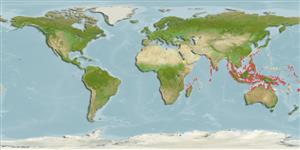Common names from other countries
Environment: milieu / climate zone / depth range / distribution range
Écologie
marin; saumâtre récifal; profondeur 0 - 5 m (Ref. 90102). Tropical; 23°C - 28°C (Ref. 13614); 35°N - 20°S
Western Pacific: Andaman Islands to Vanuatu, north to Japan, south to New Caledonia. Occurs in the Mekong delta, but possibly may be found as far upstream as the tidal zone (Ref. 12693).
Taille / Poids / Âge
Maturity: Lm ? range ? - ? cm
Max length : 16.2 cm TL mâle / non sexé; (Ref. 11344)
Épines dorsales (Total) : 7; Rayons mous dorsaux (Total) : 10 - 11; Épines anales: 1; Rayons mous anaux: 9 - 10; Vertèbres: 26. Ground color brown, darker dorsally; dusky spots proximally on pectoral fin; blackish pelvic fins. 10 or more predorsal scales. Cheeks and opercula fully scaled. Spines of 1st dorsal fin elongated into filaments. Differs from E. belissimus by having fewer predorsal scales and slightly different details of coloration (Ref. 1602); characterized further by having pectoral rays 16-18; rounded caudal fin; longitudinal scale series 30-33; ctenoid scales except cycloid on nape and isthmus; depth of body 3.6-4.0 in SL (Ref. 90102).
Solitary or in groups (Ref. 90102). Inhabits muddy bottoms of shallow, turbid marine to brackish coastal inlets and estuaries. Also lives in shallow coastal waters, large tidal pools, mangroves, siltty lagoons and brackish lakes (Ref. 48637).
Life cycle and mating behavior
Maturities | Reproduction | Spawnings | Egg(s) | Fecundities | Larves
Murdy, E.O., 1985. A review of the gobiid fish genera Exyrias and Macrodontogobius, with description of a new species of Exyrias. Indo-Pac. Fish. (10):14 p. (Ref. 403)
Statut dans la liste rouge de l'IUCN (Ref. 130435)
CITES (Ref. 128078)
Not Evaluated
Menace pour l'homme
Harmless
Utilisations par l'homme
Pêcheries: commercial; Aquarium: Commercial
Outils
Articles particuliers
Télécharger en XML
Sources Internet
Estimates based on models
Preferred temperature (Ref.
115969): 26.2 - 29.3, mean 28.7 (based on 2386 cells).
Phylogenetic diversity index (Ref.
82804): PD
50 = 0.5312 [Uniqueness, from 0.5 = low to 2.0 = high].
Bayesian length-weight: a=0.01023 (0.00477 - 0.02194), b=3.02 (2.84 - 3.20), in cm Total Length, based on LWR estimates for this (Sub)family-body shape (Ref.
93245).
Niveau trophique (Ref.
69278): 3.5 ±0.37 se; based on food items.
Résilience (Ref.
120179): Haut, temps minimum de doublement de population inférieur à 15 mois (Preliminary K or Fecundity.).
Fishing Vulnerability (Ref.
59153): Low vulnerability (10 of 100).
